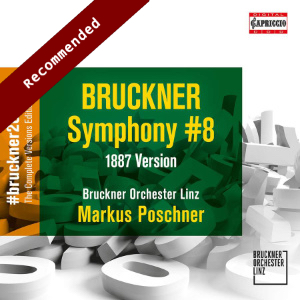
Anton Bruckner (1824-1896)
Symphony No 8 in C-minor WAB 108 (1887 Original Version ed. Nowak)
Bruckner Orchester Linz/Markus Poschner
rec. 2022, Rehearsal Hall, Musiktheater, Linz, Austria
Capriccio C8087 [82]
This is another instalment in Markus Poschner’s ongoing Bruckner 2024 complete Versions Edition, recorded with two orchestras. The series has been a very mixed bag as far as I am concerned; ‘Die Nullte’, the 1878-80 version of the Fourth and the 1890 version of the Eighth are excellent whereas I found the 1876 and the Sixth to be less successful, my main complaint being about Poschner’s propensity for haste.
The timings for this new recording of the 1887 ‘Original Version’, however, do not look at all problematic. First impressions confirm that promising indication; we immediately beautiful sound – in terms of both the engineering and the playing in a perfectly paced introduction. There is some slight reverberation around the sonorous orchestral sound and the spread and balance among the various banks of instruments are ideal; close your eyes and you could be sitting midships in a concert hall. Although I tend to take impeccable digital sound for granted these days – any flaw is now the rare exception – I am especially impressed by the depth of bass sound and the golden sheen on the brass here.
This is a warm, Romantic account yet it’s not just a wash of comfortable sound; Poschner injects little details and refinements into his interpretation, some of which are quite arresting, such as his deliberately stabbing, staccato emphasis at 12:08 in the first movement and the boldness of his control of dynamics, as in the gradual crescendo beginning around 12:50. He makes a real feature of the fortissimo ending to that movement, virtually bludgeoning the listener into acceptance of its grandeur; it certainly works for me, habituated though I am to the quiet conclusion of the 1890 version.
The Scherzo is taken fast and again, the clarity of the individual instrumental strands underpinned by very prominent timpani lends great immediacy and impact. I am convinced that the later Trio is a marked improvement over the original version played here, but Poschner caresses the gentle, surging melody, then draws out its wistfulness, applying rubato, pauses and all the tricks to enhance the phrasing before lending a little Alpine grandeur; it is beautifully done and makes the strongest contrast with the resumption of the scurrying Scherzo theme leading to a rousing conclusion.
As Paul Hawkshaw’s notes explain, the differences between the two versions three years apart are largely a matter of a reversal of tonalities of the climaxes in the Adagio and the application of cuts in both movements in the later version. I thought the last two movements the best of Poschner’s rendition of the 1890 version and as he has the same orchestra here, there is no reason to expect his delivery of them in their original form to be any less successful – and so it proves. Here is the same combination of grandeur, poise and tenderness; this is rapt playing of the utmost subtlety and flexibility. Pauses are artfully prolonged without being egregious and the tonal bloom on orchestral sound is miraculous. I don’t think I have heard the sheer sweetness of Bruckner’s lyricism so sensitively realised before, yet that does not preclude Poschner conjuring a climax of almost frightening intensity at 21:36 running through to 21:55 with some marvellously splashy cymbals.
The finale is thrilling: pounding timpani, blaring brass, sawing strings; first a race to the Abyss then it relapses into the dreamy second subject with a succession of lovely passages from low strings, horns over pizzicato violins, woodwind and flutes – all shine in their contributions. I am also delighted to hear that the slight deficiency of attack at six minutes into the movement which I noted in my review of the 1890 version is remedied here, with more thunderous drums and heavier bowing. I am swept along by Poschner’s momentum, yet, as before, he is unafraid to extend pauses to build tension, such as at 10:20. Is there music any grander than the chorale beginning 14:33? Poschner and co. certainly do it justice and the ensuing passage of scurrying violins over the punctuating brass is wonderful. The rising, then falling, octaves of the coda, beginning at 21:39, are magical and the concluding paean overwhelming.
This is an excellent recording. but Poschner’s reluctance to apply rubato in the rubato in favour of propulsiveness, attachment to clarity and a certain resistance to voluptuousness make it rather spare compared with, for example, Karajan , but if your taste is for a more “in tempo”, controlled approach, his recording is for you, especially as there are far fewer accounts of this earlier, original version in the catalogue and it is here presented in a very persuasive light.
[Just to demonstrate that I am not blinded by the excellence of this recording to any flaws, let me iterate two gripes: first, as I have previously complained, what is the point of encasing a regular, plastic, single CD case in a cardboard sleeve which most buyers will discard/recycle? Why not instead adopt the slimmer, simpler, recyclable cardboard digipacks now more commonly encountered in new issues? Second, a minor misprint – the catalogue number is wrongly printed on the inner spine as 8084, which was the number for the 1876 issue of the ‘Romantic’. But that’s all I can find to moan about.]
Ralph Moore
Help us financially by purchasing from





















